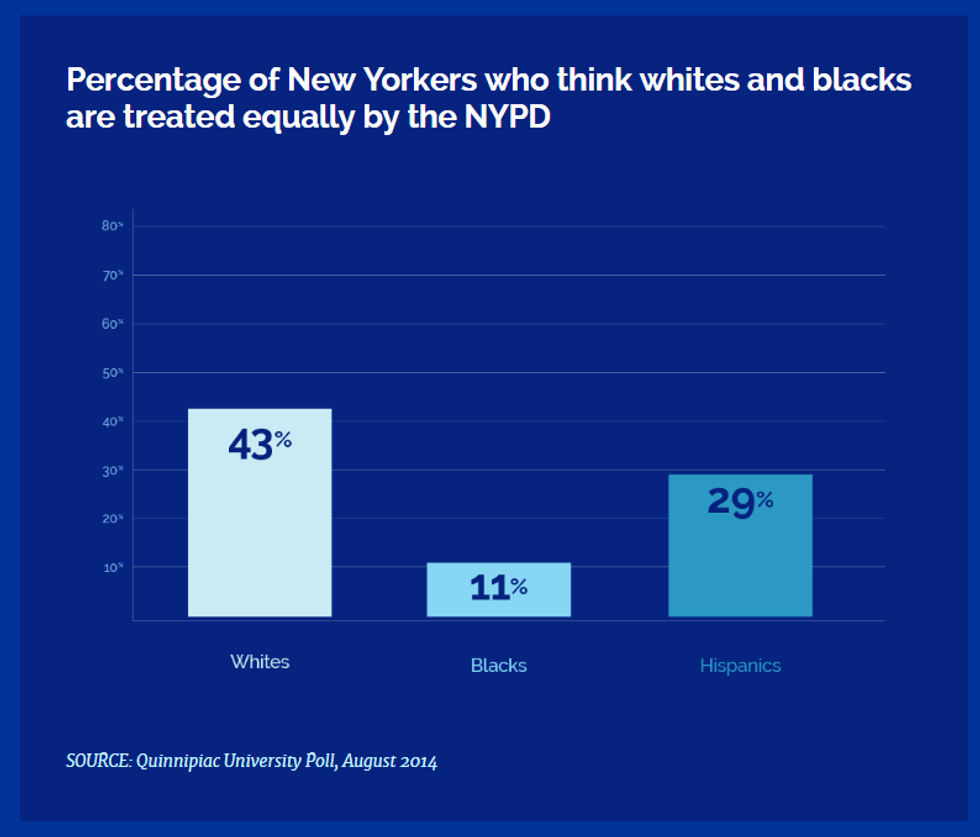The New York City Police Department, if its proposal is accepted, is offering a $4 million, 5-year contract to a public relations group in an attempt to improve its image and relations with minorities and, in turn, to strengthen its policing within neighborhoods, as reported by DNA Info.
This is a major step for the same police department that enforced a stop and frisk program which, between January 2004 and June 2012, lead to 4.4 million stops, of which 80% of the individuals stopped were black or Hispanic and 88% resulted in no further action.
In 2013, a judge concluded that the way in which the NYPD carried out its stop and frisk program violated the Constitution. This became a major point of debate in the first presidential debate of the 2016 election.
Many individuals were quick to criticize the NYPD's proposal, pointing out other ways that $4 million could be used to accomplish the same goal:
"hmm, wouldn't donating that same $4 million to local organizations in minority communities be a better way to achieve this?" - RAR18639
"so instead of building relationships, listening, & communicating with minorities they'll pay $4 mil to make it seem like they do?" - Oh It's Barbara
"Idea: Spend the $4M on training, testing, changing the blue culture of #NYPD and #lynchingbygunshot" - E_Joyce
This proposal, however, is not the NYPD's first attempt to fix the relationship between the police and those they serve, in particular minorities.
In fact, their website contains a "plan" that outlines four major points of their work: fighting and reducing crime, detecting and deterring terrorists, winning back community support, and ensuring the safety and fair treatment of the men and women of the NYPD. Each point is talked about in detail on its own individual page; the community page includes a graph detailing the alarming difference in perception of the police among racial groups.
In addition, the page also acknowledges that people with negative attitudes toward the police are in the same neighborhoods and communities where "violence leads to the highest levels of fear, and where the police are called upon by residents to do the most." It is followed by a quote from William J. Bratton, a former police commissioner for the City of New York:
"Many residents in the communities most directly affected by the dramatic crime reductions of the past two decades feel that those reductions have been achieved at their expense. The NYPD will be working with these citizens in a new partnership, built on mutual respect and an appreciation for shared responsibility, to make every neighborhood safe from crime, fear, and disorder."
The website, and this new proposal, can be seen as mere suggestions and not clear, concrete solutions which are desperately needed, but the NYPD is undeniably making an effort to provide a response to their critics and critics of the broader American police force.
Their effort can be seen in not just their words but their actions; the NYPD just last week announced that it would allow its officers to wear turbans and have beards, two big wins for Sikh and Muslim officers as noted by the Huffington Post.
As a member of the black community in addition to the LGBT community, I am hesitant in giving praise to people and organizations that present suggestions which are not immediately clear and tangible solutions. It is a natural precaution, one that should not be easily dismissed and exists as an extra layer of protection in a country where I and many members of my communities feel we are treated as if we are not as valuable as the majority is.
While the NYPD has yet to outline in great detail their plans to improve race relations, I am willing to praise them for making an active effort, one that can be seen within the community as well as within the police force itself through its efforts to increase and promote diversity.
I live over 500 miles away in North Carolina and thus I am not directly affected by the NYPD, but the police department has gained a great deal of respect from me through their stressed desire to repair the relationship between the police and minorities, something many individuals and organizations like the Black Lives Matter movement have called for more of.
Through their words and actions, the NYPD likely will end up a, if not the leader in the future of American policing as they continue to promote a more diverse force that polices with thoughtfulness and respect and promotes peace and acceptance of all American citizens.


















